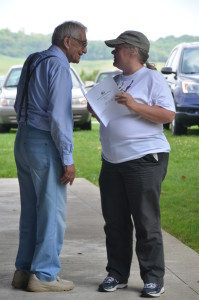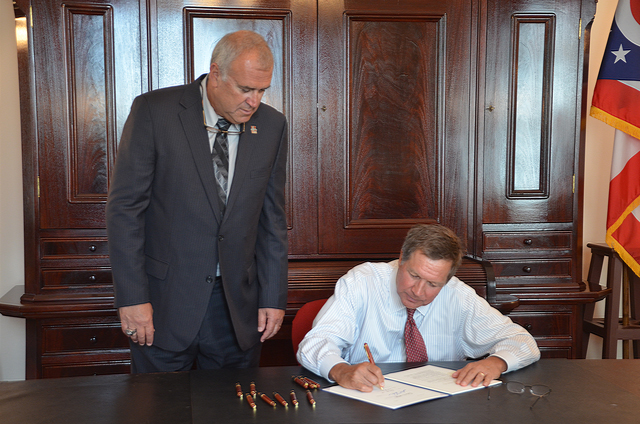Woodlands need more attention from state officials
In more than 80 years of life spent on and around Ohio’s farms, Mel Borton has seen cycles of woodlands preservation and cutting the woods on farmland.
“One sure way to remove woodlands across the state is for the real estate tax code to essentially promote chopping down trees,” said Borton.
“In my first 40 years, farmers cleared their woods as fast as they could. In my last 40 years farmers were conserving woodlands. It seems like the pendulum is swinging away from conservation and that’s a shame,” Borton added.

Mel Borton, left, talks to fellow OFU member Karen Wood at OFU’s summer picnic in 2014. The Ohio Farmers Union is the second-largest general farm organization in Ohio.
He fears that’s exactly what Ohio’s Current Agricultural Use Valuation system for taxing farmland is doing. He and other members of the Ohio Farmers Union are pleased that the Kasich Administration began fixing CAUV this year, but many, like Borton, worry that woodland valuations are still not functioning in the way that CAUV framers intended.
Borton, a retired farmer and former lobbyist for OFU, spoke out at last Thursday’s Ohio Dept. of Taxation CAUV Advisory Committee hearing.
“I told the committee that I volunteer answering phones at our (OFU’s) state office and farmers are telling me that they are clearing their woods because of CAUV,” Borton said.
“The folks in Columbus have done some good things this year to get the wild swings in CAUV under control, but they haven’t done enough on woodlands,” Borton added.
Ted Finnarn, OFU’s resident CAUV legal expert and a member of the state’s CAUV advisory committee said that woodland values will be lower in the 2015 tax year as compared to 2014, but OFU and other ag groups need to keep the pressure on the tax department to continue reviewing woodland valuations and the capitalization-interest rate.
“I think the Tax Department is moving in the right direction, but much more needs to be done to come up with CAUV values that are more reasonable,” Finnarn said.
Finnarn, a Greenville attorney, has been on the advisory committee since its inception in the 1970s. The committee met last week to hear public comment and to release the 2015 valuations for CAUV.
Ohio Tax Commissioner Joe Testa said his department has heard and responded to concerns about CAUV.
“I am certainly aware that there are some farmers and farm land owners facing tax increases but believe the factors impacting land values are moving in a favorable direction for the agriculture industry in Ohio,” Testa said.
“The CAUV remains a very valuable program for Ohio’s farmers which results in
significant property tax reductions when compared to land not being used in agriculture,” he added.
Testa said the values released last week affect the 24 counties in this year’s triennial CAUV re-valuation rotation. According to the department, the average CAUV per acre in 2015 in Ohio is $1,388, which is 17 percent less than the 2014 valuation of $1,668.
The department made changes, as suggested by the Ohio Farmers Union and Ohio Farm Bureau earlier this year.
On behalf of OFU, Finnarn worked closely with the Farm Bureau and others across the state for more than two years as CAUV values began to wildly fluctuate. Among the recent changes, Finnarn points out the following differences between the 2015 tax year and previous years:
- Modifications to the Capitalization-Interest Rate by going to a longer term fixed rate with an 80% loan-20% equity split versus the previous more restrictive 60% loan-40% equity calculation. This will have the effect of lowering CAUV values from the originally proposed values.
- Correction to woodland values by updating and increasing the costs of clearing from $500 to $1,000 and increasing sub-surface drainage to $770 and surface drainage to $380. Woodland values will be lower for 2015 as compared to 2014.
- Improving the accuracy of input data in regards to crop prices and cost data by bringing it more current in regards to crop production yields, crop price values and costs. Inputs from the Ohio State University crop enterprise budget for 2015 were put into the formula so that this represents no lag time. These costs have increased – lowering the CAUV values from the original proposal.
Finnarn said some values are still increasing from the 2012 values, but not as much as they would have without the changes. Values will not change for the 41 counties that underwent their reappraisals and reevaluations for tax year 2014 (increased taxes paid in 2015). However, these counties will benefit from the changes in the future when they recycle for reevaluations in three years in tax year 2017.







